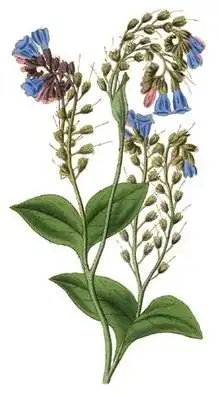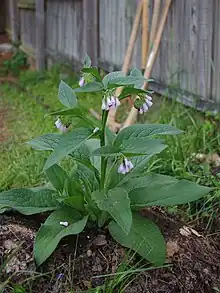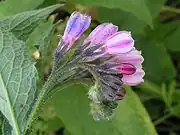Symphytum
| Symphytum | |
|---|---|
 | |
| Symphytum caucasicum | |
| Scientific classification | |
| Kingdom: | Plantae |
| Clade: | Tracheophytes |
| Clade: | Angiosperms |
| Clade: | Eudicots |
| Clade: | Asterids |
| Order: | Boraginales |
| Family: | Boraginaceae |
| Subfamily: | Boraginoideae |
| Genus: | Symphytum L. |
| Type species | |
| Symphytum officinale L. | |
| Species | |
|
See text. | |
Symphytum is a genus of flowering plants in the borage family, Boraginaceae. There are up to 35 species,[1] known by the common name comfrey (pronounced /ˈkʌmfri/). Some species and hybrids, particularly S. officinale and S. × uplandicum, are used in gardening and herbal medicine. They are not to be confused with Andersonglossum virginianum, known as wild comfrey, another member of the borage family.[2]
Species
Species include:
- Symphytum asperum – prickly comfrey, rough comfrey
- Symphytum bulbosum – bulbous comfrey
- Symphytum brachycalyx - Palestine comfrey
- Symphytum caucasicum – Caucasian comfrey
- Symphytum ibericum – creeping comfrey, Iberian comfrey[3]
- Symphytum officinale – comfrey
- Symphytum orientale – white comfrey
- Symphytum tauricum – Crimean comfrey
- Symphytum tuberosum – tuberous comfrey
- Symphytum × uplandicum (S. asperum × S. officinale, synonym: S. peregrinum) – Russian comfrey, healing herb, blackwort, bruisewort, wallwort, gum plant


Cultivation
The Russian comfrey 'Bocking 14' cultivar was developed during the 1950s by Lawrence D Hills, the founder of the Henry Doubleday Research Association (the organic gardening organization itself named after Henry Doubleday, who first introduced Russian comfrey into Britain in the nineteenth century) following trials at Bocking, Essex.[4]
Propagation
Bocking 14 is sterile, and therefore will not set seed (one of its advantages over other cultivars as it will not spread out of control), thus is propagated from root cuttings. The gardener can produce "offsets" from mature, strongly growing plants by driving a spade horizontally through the leaf clumps about 7 cm (2.8 in) below the soil surface. This removes the crown, which can then be split into pieces. The original plant will quickly recover, and each piece can be replanted with the growing points just below the soil surface, and will quickly grow into new plants. Offsets can also be purchased by mail order from specialist nurseries in order to initially build up a stock of plants.[5]
Phytochemistry, folk medicine, and toxicity
Folk medicine names for comfrey include knitbone, boneset, and the derivation of its Latin name Symphytum (from the Greek symphis, meaning growing together of bones, and phyton, a plant), referring to its ancient uses. Similarly, the common French name is consoude, meaning to weld together. The tradition in different cultures and languages suggest a common belief in its usefulness for mending bones.
Comfrey contains mixed phytochemicals in varying amounts, including allantoin, mucilage, saponins, tannins, pyrrolizidine alkaloids, inulin, and proteins, among others.[6] Pyrrolizidine alkaloids are responsible for comfreys production of hepatotoxicity.[7]Liver toxicity is associated with consuming this plant or its extracts.[6] In modern herbalism, comfrey is most commonly used topically.[6][8][9]
In 2001, the United States Food and Drug Administration issued a ban of comfrey products marketed for internal use, and a warning label for those intended for external use.[10][11] Comfrey is particularly contraindicated during pregnancy and lactation, in infants, and in people with liver, kidney, or vascular diseases.[6][12]
See also
References
- ↑ Miranda, Kimberley (9 July 2010). "Symphytum". hortweek.com. Retrieved 23 April 2017.
- ↑ USDA, NRCS (n.d.). "Cynoglossum virginianum". The PLANTS Database (plants.usda.gov). Greensboro, North Carolina: National Plant Data Team. Retrieved 2018-11-20.
- ↑ "Symphytum ibericum". rhs.org.uk. Retrieved 23 April 2017.
- ↑ Alfrey, Paul (3 June 2016). "Comfrey – BELIEVE the HYPE!". Permaculture Research Institute. Retrieved 1 June 2021.
- ↑ Teynor, Putnam, Doll, Kelling, Oelke, Undersander, and Oplinger. "Comfrey". Alternative Field Crops Manual. University of Wisconsin, Extension, Cooperative-Extension. Retrieved 25 March 2014.
{{cite web}}: CS1 maint: multiple names: authors list (link) - 1 2 3 4 "Comfrey". Drugs.com. 17 July 2017. Retrieved 22 May 2018.
- ↑ Mei, Nan; Guo, Lei; Fu, Peter P.; Fuscoe, James C.; Luan, Yang; Chen, Tao (October 2010). "Metabolism, genotoxicity, and carcinogenicity of Comfrey". Journal of Toxicology and Environmental Health Part B: Critical Reviews. 13 (7–8): 509–526. doi:10.1080/10937404.2010.509013. PMC 5894094. PMID 21170807.
- ↑ Grant, G; Nolan, M; Ellis, N (July 1990). "A reappraisal of the Malaise Inventory". Social Psychiatry and Psychiatric Epidemiology. 25 (4): 170–8. doi:10.1007/BF00782957 (inactive 31 October 2021). PMC 2399473. PMID 2399473.
{{cite journal}}: CS1 maint: DOI inactive as of October 2021 (link) - ↑ Miller, Lucinda G. (9 November 1998). "Herbal Medicinals: Selected Clinical Considerations Focusing on Known or Potential Drug-Herb Interactions". Archives of Internal Medicine. 158 (20): 2200–2211. doi:10.1001/archinte.158.20.2200. PMID 9818800.
- ↑ "FDA/CFSAN – FDA Advises Dietary Supplement Manufacturers to Remove Comfrey Products From the Market". Food and Drug Administration. Retrieved 2007-06-01.
- ↑ Koll, R; Klingenburg, S (2002). "Therapeutische Eigenschaften und Verträglichkeit topischer Beinwellzubereitungen bei Prellungen, Zerrungen, Verstauchungen sowie bei schmerzhaften Muskel- und Gelenkbeschwerden: Ergebnisse einer Beobachtungsstudie an Patienten" [Therapeutic characteristance and tolerance of topical comfrey preparations. Results of an observational study of patients]. Fortschritte der Medizin (in German). 120 (1): 1–9. PMID 14518351.
- ↑ Yeong, Mee Ling; Swinburn, Boyd; Kennedy, Mark; Nicholson, Gordon (March 1990). "Hepatic veno-occlusive disease associated with comfrey ingestion". Journal of Gastroenterology and Hepatology. 5 (2): 211–214. doi:10.1111/j.1440-1746.1990.tb01827.x. PMID 2103401. S2CID 42511497.
External links
- Giannetti, B. M.; Staiger, C.; Bulitta, M.; Predel, H.-G. (1 July 2010). "Efficacy and safety of comfrey root extract ointment in the treatment of acute upper or lower back pain: results of a double-blind, randomised, placebo controlled, multicentre trial". British Journal of Sports Medicine. 44 (9): 637–641. CiteSeerX 10.1.1.1030.3598. doi:10.1136/bjsm.2009.058677. PMID 19460762. S2CID 5432523.
- Healthline